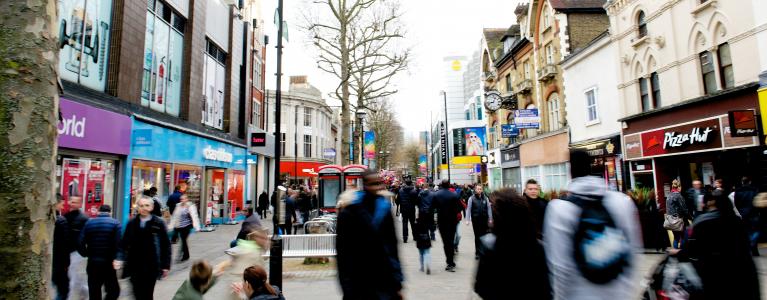
The first Good Growth by Design recovery roundtable brought together Mayor’s Design Advocates, borough representatives and thought leaders. They discussed the impact of the COVID-19 pandemic on London’s highs streets and town centres, and how this will affect the recommendations in City Hall’s High Streets & Town Centres: Adaptive Strategies guidance. The report, which was published in January, shows that our high streets are more than retail, focusing on their social and community value. The guidance advocates a ‘mission-orientated’ approach to the development of ‘adaptive strategies’ for high streets renewal through innovation and experimentation which responds to locally specific concerns.
The roundtable participants agreed that the health emergency has accelerated many of the trends which were already impacting the high street, with the potential for growing inequalities across the city as some areas will be more affected than others. The group reassured us that a mixed-use high street of short distances, where people of all ages and backgrounds can meet, access services, shop, work and live, is still the right way forward. Holly Lewis, co-author of the guidance, remarked that “the fact that 90 per cent of Londoners live within a ten-minute walk of their local high street is even more important than ever.” Contributors stated that the door is now open in a way that is possibly even greater than before the pandemic to act on the Adaptive Strategies recommendations: physical-digital retrofit; new forms of engagement, participation and ownership; new types of workspace; reduced car traffic and more active travel; and more civic spaces.
Below we give an overview of the principles set out in the report, what they could mean in practice and highlights of the roundtable discussion.
Supporting inclusive economies
Treat the high street as a business incubator. Plan for adequate workspace to support diversity within the future vision, and carefully consider retention of existing building to support viability and continuity of local businesses. For example, this could be the promotion of new models of collaboration between local authorities, local communities and businesses.
Lucy Webb, Head of Regeneration at Croydon Council observed that "we are watching our businesses themselves coming together on the high street to mobilise local people, a mutual aid movement that we desperately want to hold on to and build on as we go forward."
Simon Pitkeathley, LEAP Board member and Chief Executive of Camden Town Unlimited confirmed that "small business entrepreneurs have always been good at innovating up to a point, but then they hit other barriers. They have to become building managers, leaseholders, accountants. We should try to help unlock these barriers in order to help these areas."
In practice: Read about the Church Street case study in Westminster on page 123 of the High Streets Adaptive Strategy guidance, which is also part of our Good Growth Fund programme.
Manage assets innovatively
Coordinate a property strategy that enables publicly owned assets to support strategic goals. Define and agree with stakeholders Key Performance Indicators to be incorporated within leases and other agreements to promote and deliver social value.
For example: Review and document community value creation by existing tenants and use this to inform a property strategy.
Vidhya Alakseson, from Power to Change, said "We’re working on the concept of Community Improvement Districts, developing new governance models for high streets. Central to this is getting a different mix of players around the table. Community organisations have a lot to offer, but they’re often not in those strategic conversations."
In practice: Read about the International House Workspace, Brixton
Digitally transform
Establish a baseline and employ high and low-tech data collection to measure against defined aims.
For example: Use existing and emerging centralised assets including Town Centre Health Check and Night-time Data Observatory, to set baselines and the contextual position.
Christopher Hayley, from Nesta, said "One of the things this crisis is going to do is accelerate a vast shift toward digital. It’s even more important now that we get high street firms, and SMEs more generally, to think about digitisation, otherwise they are going to be left behind."
In practice: Read Nesta’s collective intelligence design playbook
To receive City Hall’s High Street Recovery Newsletter and hear about updates on policy, projects, events and opportunities from the Mayor of London's regeneration team, sign up below.